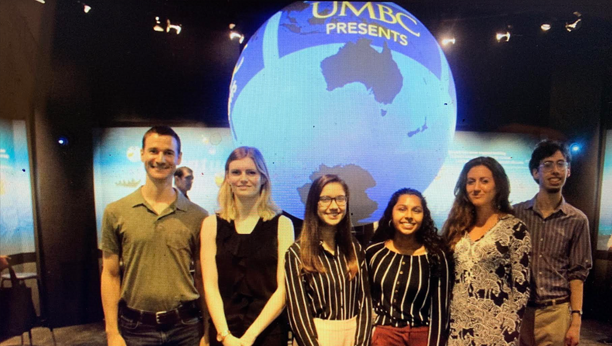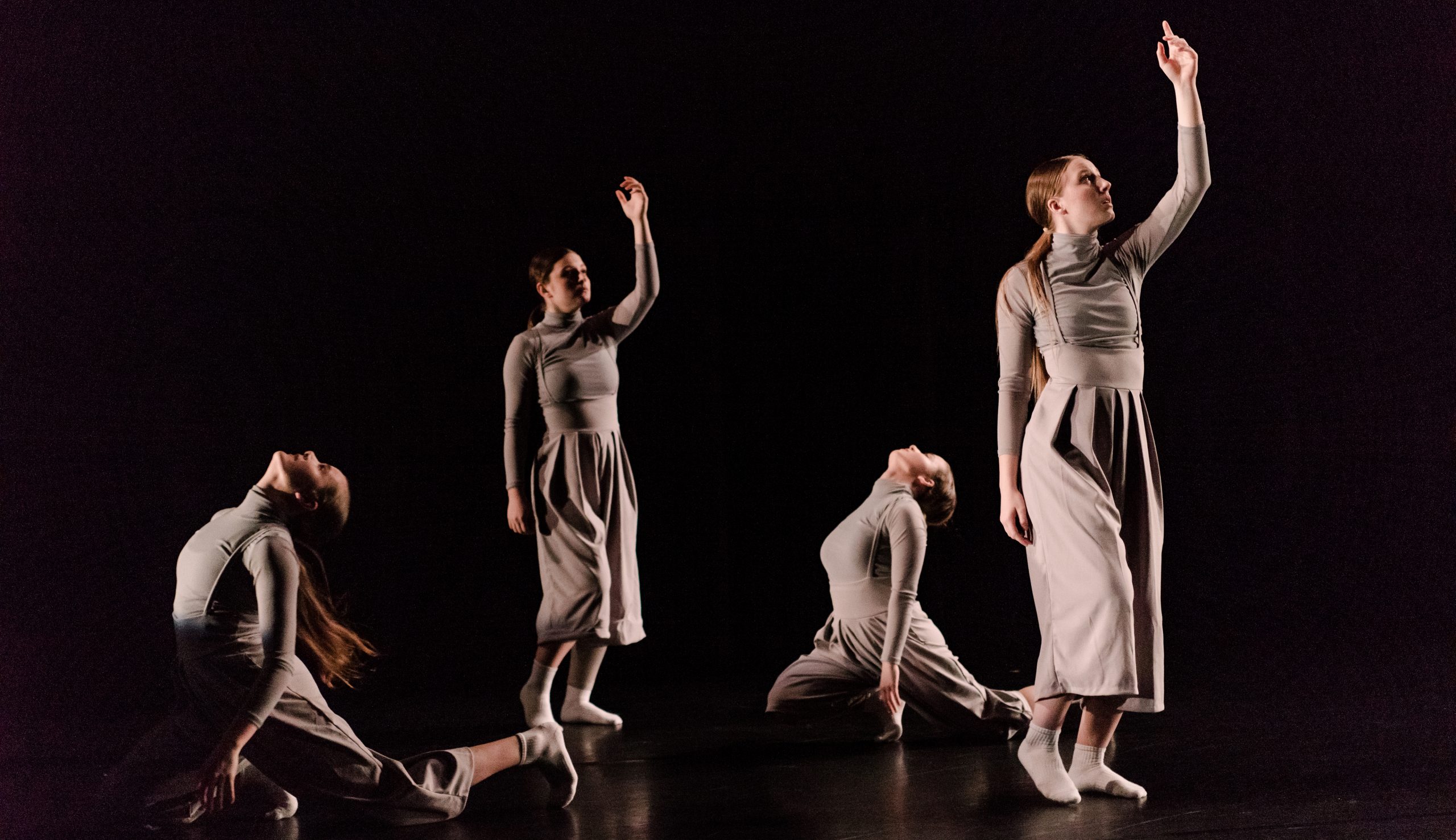Nothing in Undergraduate Research and Creative Achievement Day’s twenty-four year history could have prepared its organizers and participants for the challenge presented in spring 2020, as COVID-19 pushed what would have been a heavily-attended event into a virtual space online.
Using a technology called VoiceThread, student researchers uploaded poster presentations, performances, and visual artwork, adding commentary and responding to questions from the online audience—mimicking the in-person experience—and URCAD XXIV transformed from a single day into a week-long event stretching from April 22 to 29.
Keisha John ’03, biochemistry and molecular biology, provided a video message about leadership with integrity for URCAD XXIV’s opening remarks as the annual alumni guest speaker. A former Meyerhoff Scholar, she is now associate dean for diversity and inclusion in the Graduate School of Arts and Sciences at the University of Virginia.
“Hosting URCAD online gave students a new skill set, which involved producing a virtual presentation — an ability that they will absolutely need going forward in their future academic and professional lives, given the huge cultural shift that has happened due to the coronavirus pandemic,” said April Householder, director of undergraduate research and prestigious scholarships in the Division of Undergraduate Academic Affairs.
“The students really jumped in with both feet to the new technology and made some really dynamic presentations. They created voiceovers for their posters, made videos, and converted their live performances to the web. And they did that in a very condensed amount of time with a very short learning curve.”
URCAD usually attracts about 2,500 attendees, but this year’s online event far surpassed that number. The URCAD site was viewed 18,771 times—more than 8,200 times on the first day alone—and 2,971 unique users logged in, with visitors from as far away as the United Kingdom and South Korea. The VoiceThreads were viewed 3,750 times (with Angela Endres, visual arts, leading the pack at 97 views) and collected 2,671 comments (with Kenneth M’Bale, media and communication studies, topping out at 52).
Although URCAD has come to a close, the 251 online presentations will remain online until September 4 so the university community and beyond may continue to explore the remarkable depth of student research and creative achievement.
Creative solutions in engineering and medicine
In presentations in disciplines ranging from environmental engineering to information systems, students in the College of Engineering and Information Technology shared insights from their research.
Fatima Talib ’20, chemical engineering, working alongside Mariajose Castellanos, senior lecturer in chemical, biochemical and environmental engineering, researched how to produce clean water and energy through an existing engineering process.
“I became interested in this topic when I heard about billboards that use natural humidity to produce drinkable water in Peru. I realized there was a disadvantage in countries that lack humidity,” Talib says. Her presentation focused on how organic waste, such as food waste and paper, can be used to create potable water, electricity, and fertilizer, while minimizing the production of carbon dioxide.
Yianni Karabatis ’21, computer science, presented his work on using deep learning to more accurately diagnose breast cancer. Karabatis, who worked with Konstantinos Kalpakis, associate professor of computer science and electrical engineering, explained that a significant percentage of people will be diagnosed with breast cancer in their life, and it is important to have a trustworthy system in place to correctly make these diagnoses.
“The goal of this project is to increase diagnosis accuracy, while refining interpretation of difficult cases and reducing fatigue and increasing efficiency of pathologists,” he shares. He developed a Convolutional Neural Network, a system of computation inspired by the human brain, which after the first round of training achieved 88% validation accuracy.
Transcending the gallery and theatre
While live performances and in-person exhibitions and screenings were not possible this year, the VoiceThread platform gave rise to a deeper look into the scholarly research and technical processes that go into creative works across the arts.
In her presentation “Authorship and Animation,” Linehan Artist Scholar Olivia Mills ’20, visual arts, challenged the notion of animated film projects as big studio productions, noting direct access to tools and audience is within grasp for independent filmmakers. She presented a compelling overview of the production processes for her animated film, Creatures in Crisis, commenting that “this process is a marathon in nature, requiring patience and multitasking with the unique and time-consuming challenges animation presents.” Her hope is to inspire others to overcome technical challenges or skill barriers to authoring one’s own animated story.
In A Mile in My Cleats, a short documentary film by Linehan Artist Scholar Courtney Culp ’20, visual arts, four black female athletes at UMBC reflect on their experiences as Division I athletes in basketball, volleyball, lacrosse, and track and field (freshman Tyler Moore, freshman Carmen Freeman, senior Zoë Pekins, and sophomore Ariella Garcia, respectively). In the film, each student shares personal anecdotes revealing the questions and pressures they have endured as black athletes. They also share the cues—from media representation, microaggressions, sexism and the ever-present undercurrents of racism—on what society expects from them.
“Overall my biggest takeaway was realizing that through my documentary, I was able to give others the space they needed to share their stories of what it’s like being a black female athlete,” says Culp. She “finished the project with an immense amount of new knowledge of my craft and closer relationships with my peers at UMBC.” Culp’s film was shown earlier this year at the annual Race and Sports Day at the National Civil Rights Museum in Memphis.
Linehan Artist Scholar Emily Godfrey ’20, dance, presented her work terminal, with choreography that explores the individual choice forced upon family members when a family dynamic is drastically changed forever. “The piece is intentionally left open-ended, leaving the audience to reflect, react, and invoke discussion,” shares Godfrey. “So long as the work resonates with the viewer, the experience is what matters, not the presentation of a theme.”
Just prior to URCAD, Godfrey’s work was presented at the gala of the American College Dance Festival’s Mid Atlantic North Conference, along with Giving Skin by Teresa Whittemore ’20, dance.
Seeking greater understanding
In a world with many uncertainties, UMBC students in the humanities and social sciences seek greater understanding through research on global, national, and local topics including environmental change, presidential electability, and food insecurity in Baltimore City.
Cameron Rybacki ’20, political science, wanted to understand her peers’ voting behavior during a highly controversial presidential election year. In Rybacki’s research project, Assessing the Electability of U.S. Presidential Candidates, she surveyed twenty-five peers to predict how they would vote, and how they chose a candidate. The preliminary findings showed that this group of college-age voters were most likely to choose candidates based on their party identification.
Nihira Mugamba ’22, political science, presented her research on Establishing Food Inequality In Baltimore City: The Influence Of Race And Poverty On Food Insecurity, drawing from data sources from a range of Baltimore City government organizations, Johns Hopkins Livable Future data, and interviews with local food justice organizations. She seeks to understand how structural racism has affected food accessibility in Baltimore’s black communities.
Mugamba is also the 2020 recipient of the Newman Civic Fellowship which acknowledges students’ commitments to educational access and responsible citizenship.

Paul Ocone ’20, individualized study; Lauren Patel ’20, environmental science; Sangita Ramaswamy ’20, biological sciences; Tori Nelson ’20, environmental science, collaborated to produce the interdisciplinary work On Thin Ice. This sixteen-minute film, formatted as a sphere, tells the story of global warming through videos of changing natural habitats and heat maps.
BUILDing confidence
UMBC’s NIH-funded STEM BUILD program intends to increase the diversity of the workforce in biomedical sciences, and six BUILD Trainees presented at URCAD XXIV.
The research of Shehar Yar Awan ’20, biological sciences, who works with Erin Green, assistant professor of biological sciences, focused on SET5, a yeast protein that has a counterpart in humans. Awan intends to increase understanding of SET5’s activity in cells, which has been linked to tumor formation. “Thanks to the STEM BUILD team’s constant academic and emotional support, I was able to effectively organize and present two years of my undergraduate research,” Awan shares.
“STEM BUILD prepared me through two Summer Bridges by teaching me how to create posters and present them,” shares Sara Reagan ’21, biological sciences and psychology. “I really felt confident making my URCAD poster on my own due to my summer experiences.” She conducts research at Johns Hopkins University on the long-term outcomes for individuals with Tourette’s Syndrome, a condition that causes severe motor or verbal tics, such as throat-clearing or repeating certain words.
Victor Omoniyi ’20, biological sciences, was also well-positioned to present at URCAD because of his prior training and experience with STEM BUILD. “STEM BUILD has supported me in my research in many ways, from funding my trip to present research at the Annual Biomedical Research Conference for Minority Students in California last year, to ensuring that I found the right mentor to conduct research with,” Omoniyi says. He uses fruit flies to study neurodegenerative disorders with Fernando Vonhoff, assistant professor of biological sciences.
“I was proud to showcase my hard work on a virtual platform,” adds Ena Oboh ’21, biological sciences. She conducted research with Rachel Brewster, professor of biological sciences. Oboh’s project focuses on how certain genes may allow zebrafish embryos to survive for long periods without oxygen, which has implications for everything from organ transplants to cancer.
“STEM BUILD has supported and prepared me for events like URCAD since I was a freshman,” Oboh says, “and gave me the tools necessary to seek advice during the process of preparation.”
Looking forward
Administrators and professors who have worked for months with presenting students applauded their efforts, especially given the sudden change in presentation methods.
“In these challenging times, our students’ dedication to carry on and participate in URCAD is nothing short of remarkable,” says Katharine Cole, vice provost and dean of Undergraduate Academic Affairs. “Their grit, enthusiastic imaginations, hard work and unwavering commitment in the face of challenge is a reflection of their resilience, determination and immense talent.”
The UMBC community now looks forward to URCAD XXV in spring 2021 with hope that crowds will once again fill the University Ballroom and studios in the Fine Arts and the Performing Arts and Humanities Building.
Engage with student work from URCAD XXIV online here through September 4, 2020.
Catherine Borg, Catalina Dansberger Duque, Sarah Hansen, M.S. ’15, and Megan Hanks Mastrola contributed to this article.
Header image from Emily Godfrey’s work, terminal. Image by Marlayna Demond ’11 for UMBC Magazine.
Tags: Research, Resilience, UMBCTogether, Undergraduate Research

